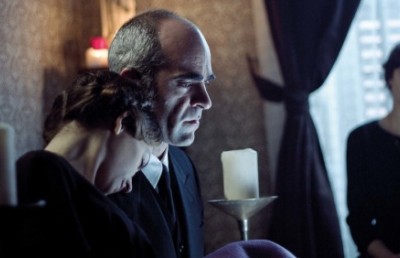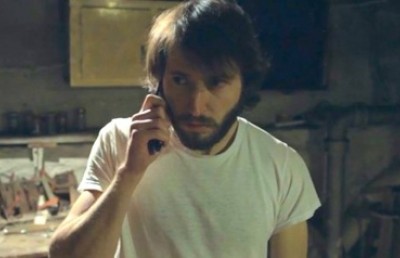Sonny Mallhi at Fantasia 2015
Interview with Donato Totaro
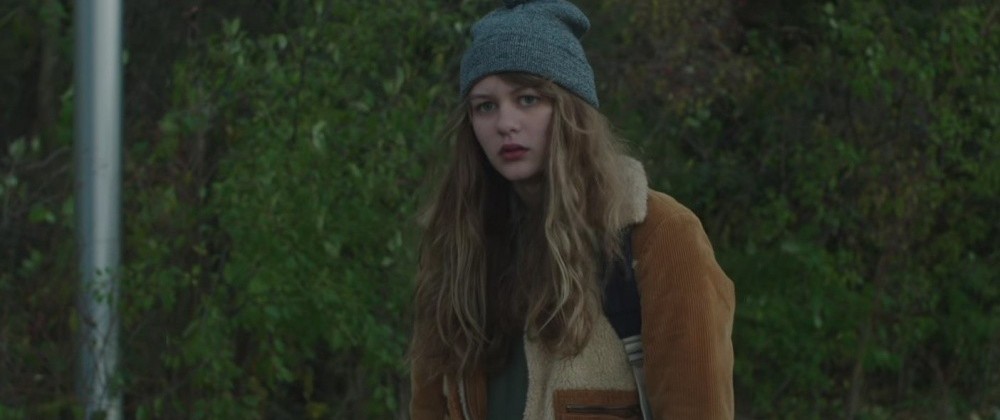
The psychological horror film Anguish was one of my top picks at Fantasia 2015. Anguish is a smart, taut horror film that channels some great horror films of old and recent into an examination of the thin line between horror of the mind and horror of the supernatural. For the better part of the film writer director Sonny Mallhi keeps the cause of the young female central character Tess’s (Ryan Simpkins) visions ambiguous, stemming possibly from a medical identity disorder or a genuine supernatural intrusion. It is rare that a film can play this tension so well and, more importantly, work as both a genuinely caring look at teen alienation, manifested as mental illness, the struggles of motherhood, and supernatural horror. Anguish opens with a tragic car accident where a mother, Sarah (Karina Logue) loses her teenage daughter, Lucy/Lucinda (Amberly Gridley). Another similarly aged girl, Tess (Ryan Simpkins) moves into the same neighborhood with her mother, Jessica (Annilka Marks) having to relocate due to Tess’s anti-social behaviour at her previous high school. She soon begins channeling the spirit of Lucinda, but narratively Tess’s medical history with delusional thinking and possibly schizophrenic behaviour evens the stakes. Mallhi’s sensitive script, performances, and use of urban spaces manages to at once invoke centuries old tradition of witchcraft (being in communion with the supernatural) with modern psychiatry and medicine. Anguish is Mallhi’s debut film as a director, but he is no stranger to the horror genre as both a writer and producer. His horror titles as a producer have included Shutters (2008), The Strangers (2008), The Roommate (2011), House at the end of the Street (2012, starring Jennifer Lawrence), Crush (2013), and At the Devil’s Door (2014). Mallhi took time from his busy schedule to answer a few questions after his screening at Montreal’s Fantasia International Film Festival.
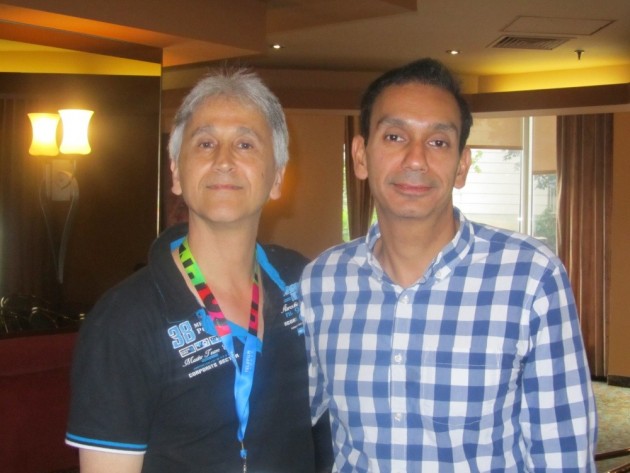
Author with Sonny Mallhi
Donato Totaro: You mentioned your mother going to India or being in India so you obviously have an Asian-American background. You’re born in the U.S., but ….
Sonny Mallhi: Born and raised in Chicago.
Offscreen: How did you get into film?
SM: It was always a love. My parents loved movies. A lot of it was going to see Indian movies. As I grew up, I didn’t think of it as a potential job. I went to college in Political Science and International relations. Right out of College, I went to D.C….worked in politics. Went to University of Chicago and took a couple of night film theory classes. I didn’t think of it as “this could lead to a job”. But then I was going to go back to D.C. for a PhD. in International relations and thought: “you know? I really like movies, I’m just going to try it.” I drove out to L.A. and became an unpaid intern, then worked at a production company. I really didn’t know anything about the process of making a movie. I thought I would just go and work at a production company. So that turned out to be the finding and developing a script side, so it’s really more script based. Then I ended up getting a job at this company called Vertigo Entertainemnt; the company had started with Roy Lee, who made all the Asian remakes with The Ring and The Grudge. So I was there at the ground floor. Lee loved horror movies and it evolved from there, with these widely appreciated, really great genre films. We did other things too, this movie called The Lake House was the first movie. You just kind of move up there and then find some projects and then one day: ”Well, no one else wants to go produce this thing…do you want to have a go? You know the writer and the director, so go ahead…fake your way through it; pretend that you know stuff… it works out and then you become a producer!
Offscreen: That’s one nebulous position that people don’t really know is actually what a producer does.
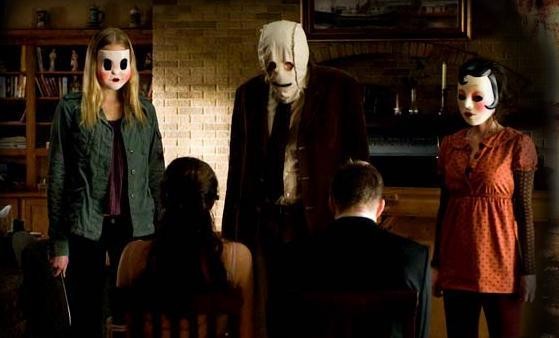
The Strangers
SM: No one knows what a producer does! The first movie I was in charge of was this movie called The Strangers, and it worked out. Everybody said: ”O.K.; you’re the producer .” So it sort of evolved and one day, we would set up projects and I had an idea, let’s do like a “Single White Female” kind of thriller in college. I had a bunch of writers coming in and I’d say: “If you write it…we’ll sell it.” Nothing was good and I had a specific thing in my head, I knew what it was. One day I just said “screw it; I’ll just write it.” It was called Friend which I first wrote under a pseudonym, no one in my company knew I wrote it and then it became The Roomate under my company name, Gravitas Ventures; we had a first look deal, so we had to give them the script first. They submitted it, they bought it and after the fact I told everyone I wrote it; it went from there, it did well, and I wrote something else. I like to wear a few hats, on some movies I’ll just go off and produce; some movies I’ll handle the financing for, or executive produce and somethings I want to write. I wrote this script and I was about to sell it to a studio and at the last minute, kind of like my career, I said: ”OK let me just try to direct it; let me just try to do it my way.” It’s something cool just to do it, for better or for worse, to find out. At least for me, it was going to be regret if I didn’t try…you never know. I just wanted to try and do a project my way as much as possible.
Offscreen: Did you produce this one as well or not?
SM: Yes, pretty much , although I worked with my friends, I was still the most experienced producer on it. The writer-director can go together obviously, but the managing and the directing was a lot. It also helped with the directing because I knew what would be the best way to figure things out in terms of shooting and style.
Offscreen: It’s interesting, something I’ve noticed across all your works, the ones I’ve seen, this theme of someone thinking there’s someone else, of being obsessed or possessed; or transferring themselves into another body, like in At the Devil’s Door. What appeals to you about that particular theme?
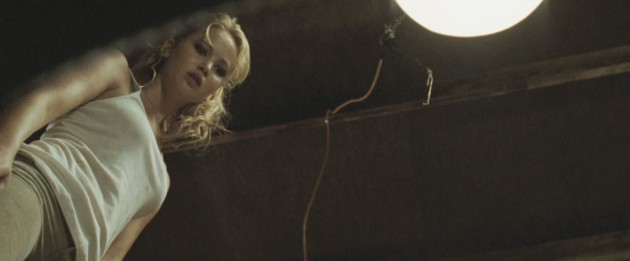
The House at the End of the Street, with Jennifer Lawrence
SM: At the heart of it, I still like psychological movies, and they come in different forms, and there’s very much some sort of relationship….just sort of the psyche of someone. With The Stranger a lot of that movie was, “who are these people” and “why are they doing this to us, just because we are home?” We don’t really answer the question, and that’s what appealed to me; it’s what was fascinating, that’s real to me. Whereas with The Roommate, it was just a fun thriller, and there is nothing wrong with that. But analysing someone who is in society but is a bit off; trying to do a study, the psychological aspects of it. In Anguish, it’s a study of how the girl reacts to having these things happening to her. She thinks “this is happening again” and she’s sort of going at it alone, and not telling anyone. The really interesting aspect to me is the mother, putting yourself in her shoes; if you’re that mother…what do you do with your kid? Most people have been in this position before; how do you react when someone is sick and no one is helping them, so again analysing people. It is just fascinating to me how people just trust blindly, and I do it too…and you should, I think you should, but even to the point of…
Offscreen: Healthy scepticism…
SM: A doctor, if you have cancer or whatever, the doctor says: ”50/50 chance”, and then you hear a guy who was working and cures people…you have to go down there and you never know. Are you going to accept the 50/50 chance or…maybe something less. I would do it too. There’s something interesting as to why we are not open to other things. Part of the big thing was in analysing the people in the story and as as extension of myself; I’m completely skeptical, I don’t believe anything.
Offscreen: Yes because the mother just tries and tries medicine, the medical authorities, and ultimately…
SM: By circumstances she is forced into it by her daughter. And then when nothing else is working she tries for a scenario that most people in her place would not go to. They would have to be hit on the head to really believe in it. As an extension of myself, I am a pure skeptic. I do not believe in anything. I wish I could, but I can’t bring myself. Everyone has had little things happened to them they can’t explain and a couple have happened to me, but I can’t bring myself to believe in them, even if I want to believe in the supernatural.
Offscreen: You do on the printed page. Did the experience your mother had with that woman in India [told to the author pre-interview], did that affect her?
SM: My mom is one of those people who really believes in all of that. I argue with her all the time! It’s like Sarah is inadvertently worldly you know, her parents took her as a kid, she kind of, like, travelled…so she was sort of exposed. Interesting because whether I’m skeptical or not, I’m generally fascinated by people who believe that stuff. I want to believe, and I’ve come to terms with it. I’m skeptical but accept that people can believe what they want to help them through.
Offscreen: The Sarah character, the one thing she does where she buries her daughter next to the road where the incident occurred.
SM: Well that I think is just a memorial…
Offscreen: OK, I wasn’t quite sure if she was actually buried there or it was just a memorial.
SM: I’m sure they do it here too.
Offscreen: You talked a bit before the film last night about the spirituality; there just aren’t that many spiritual horror films, if you eliminate the Christian ones…which is most of them…you’re left with a handful right? Audrey Rose (1977); there’s a film called Sauna (2008), a Finnish film from a few years back that was very metaphysical so there’s a few of them but there aren’t that many of them so maybe talk a little bit about what a spiritual horror film means to you. It’s clearly different from The Exorcist (1973) or The Omen (1976).
SM: The through line of the story is what actually happened. It wasn’t like me forcing that aspect of it. It’s like a different perspective, and I’m not spiritual or religious. I come on more as being superstitious. What was fascinating about it was this spirituality was just a way in which you can approach it with a different angle. In religion there is a lot of over simplifying. Maybe they want you to be fearful. I’m not going to begrudge anyone who believes in this, and if it helps them to move on, in this case if it helps your daughter to move on, or puts you at peace, then great. The spirituality made me a little bit more open to it.
Offscreen: I think the question I should ask is how did you project this idea of the spiritual, and not just in the plot, because I think you do it in other ways. This might seem like a very esoteric or pretentious way to go about it, but when I saw the film, I thought about the modernists and the period of the 1900s and how they were the first group of artists who started thinking of the spiritual through abstract forms. Walter Kandinsky wrote a book in 1912 called Concerning The Spiritual in Art where he talks about the spiritual properties of colour; the whole book is about different colours and how they relate to psychology and emotions, or the Post-Impressionists…the canvas, seeing reality as a sequence of triangles and spheres and cones and the light and shadow. So the idea of form itself being spiritual. There’s a quote from this book I’ve recently been reading, it’s a book called Film & Art by Bruce H. Hinrichs (1999, 2002): “A Primitive and pre-historical art exposed the retinal truth, modernism yearns for cosmic truths beyond the retina. From within the psyche rather than the prairie, from the dreamscape rather than landscape” (p. 91). So I think with your film, one of the things I saw, is you go beyond this retinal truth with the use of sound, for one thing, and sounds that we really can’t see, sounds that are non-diegetic, non-synchronous sounds, and I love that moment where the doctor asks her to describe the sounds and she goes like this, pointing to her head, they are in our head right?
SM: And just almost with the pain of it too you know?
Offscreen: It relates to the flashback when she’s hitting her head.
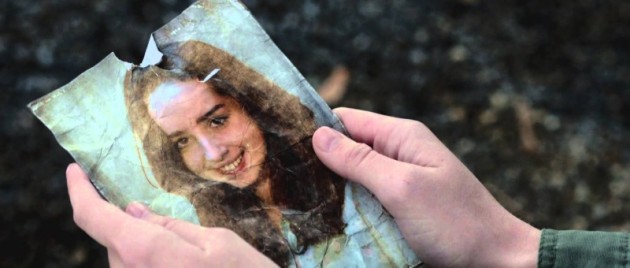
Lucy’s Memorial Photo
SM: Yes, there’s a lot of it…what’s being spiritual..is it something around her or is it something going on in her head? It ends up going into what’s real and what’s not and I think that in a lot of ways it doesn’t really matter; it’s whatever gets you through it. Is that spirit world out there, or in your head? It is meant to work on both those levels. For Tess, the main girl…this happening to her or not happening to her, could easily just be her trying to handle it herself. She spiritually checks out; I mean none of it actually happens to her till she sees the picture of Lucy by the road, her memorial, and her face is smiling, like she is happy, so it easily could be her just projecting. Again the spirit world could be a religion, or it could be unknowable, I don’t know if it’s real or not. Again I’m skeptical…I hope it is. But it could very well be just us projecting how it is. Yes sounds and everything sort of reflect that.
Offscreen: Yes, wonderful sound design…you do a good job just scaring the heck out of us just with the sound, but the stuff you do subtly is a bit more interesting in terms of that spiritual stuff.
SM: I think that the sound design works as if it should be a horror movie as well and I think part of a sound design is to, almost on a crass level, remind us that we’re watching a horror movie. It should not over-power the rest of the dramatic elements.
Offscreen: Yes, like punctuating; it’s funny because then at the end, we hear her singing the song, for the first few seconds, it was bothering me for a host of reasons, but then I realized…that’s the point. In the sense that that’s kind of what the audience expects, if she can sort of express her emotion through this simple song, it must mean she’s OK; must mean that she’s gone beyond it.
SM: Well maybe, do you …maybe there’s a different interpretation, but for me….that’s Lucy. Lucy doesn’t leave.
Offscreen: Oh, that is Lucy singing the song. She decided NOT to leave!
SM: People have different interpretations but for me that’s….
Offscreen: That happens after the scene of the battle for the spirit right?
SM: Yes and Lucy won.
Offscreen: OK, well that’s kind of like The Exorcist isn’t it? (laughs)
SM: No, in The Exorcist ……
Offscreen: There’s this whole debate about who wins; does good win because both priests, Karras and Merrin are dead …
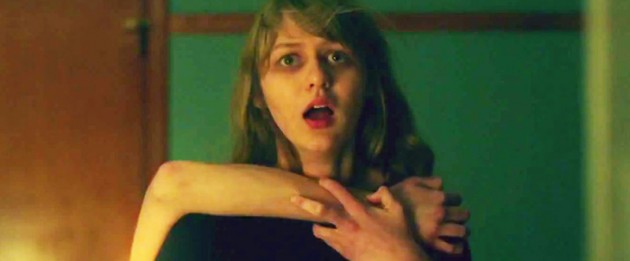
Ryan Simpkins as the tortured Tess
SM: But doesn’t he kill himself?
Offscreen: Yes, the girl is saved in the end, but a lot of people say that the devil’s whole point was to kill the two priests because he had a back story with Merrin. Merrin was the one who exorcised him in Africa earlier in the story. The way the demon plots these things for Merrin to find during the opening Iraqi sequence to draw him to Georgetown. There’s a reading where the demon actually does what they want it to do: get rid of these two priests. Your reading I hadn’t thought of that because she does play the guitar, that’s the one thing the father bonds with…this guitar playing; teaching her how to play guitar and how they get callouses so I really thought it was her, Tess.
SM: I think it can work. What’s really interesting about people watching it is how they read it reflects them. Like you probably have a pretty positive outlook (laughs).
Offscreen: But at the end when her eyes go, then I know…she’s not cured.
SM: I mean you can interpret it as Tess heard the song or knew it, but for me it’s a like I’m saying: ”OK..I believe this…this was real.” A lot of stuff in the movie I can explain, but with the song…there’s no way this girl would know that song.
Offscreen: I guess what I meant to say is, whoever it is whether it is Lucy or Tess, she’s expressing it in a very forward way that we can all understand; all that stuff you did with the sound…the texture…you’re kind of fooling us to think one thing and think another thing, whereas there..it’s very direct. This is a song about soul, pain.
SM: It is also the end of the movie which at some point you have to direct!
Offscreen: How about another of my favourite scenes where she’s with the priest and the priest begins to recite and she recites it for him…what is that about? Where is that coming from?
SM: It’s a priest who feels like he can help and in films it is always the priest who thinks he can help, right? So he comes in and he, whether he’s worried about her or not…to me, it’s her. The problem is not that she is not religious, because she does go to church with her mother, her family, but it is her way of saying: ”Look man, it’s not helping.” You are not teaching me anything here? That’s Tess. And her saying I am just tired. It is her saying look I am not ignorant of this stuff but it is not going to help.
Offscreen: Later, there are nice moments where they’re saying “are you Tess…are you Lucy?” And she goes like this and says no to both. At that point I think she’s completely lost it or there’s a third character that we don’t know; another soul that just kind of floated into the room.
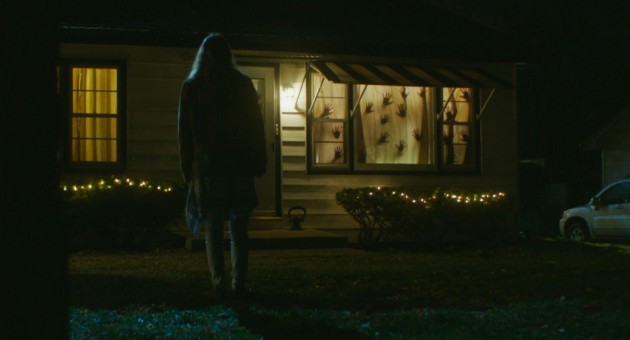
SM: She kind of warned them and I think that’s part of it; is it Lucy lying about it? Lucy’s point of view is really interesting; her coming back. I think the parents don’t want her to leave. With Lucy’s personality it is not about closure, she could care less about closure. And she found a way back and does not want to leave. Her psychological state is really interesting. Maybe she made a mistake and should move on. Lying about it at the end, for me it’s kind of creepy. Lucy finding her way back and deciding to play along.
Offscreen: Your film, what it does in the scene where they’re fighting for the control of the souls in the spirit world, when she says “I want one more night”, that’s such a touching moment. It’s almost a cliché but it works so well because it shows you even though we may be spiritual people, we want the physical world too right? You desire the physical world. So this idea that spirit is great, the spirit may live forever but I want another night…another physical night.
SM: You take her point of view; let’s say the spirit is real, and you are a priest exorcising the girl, you’re kind of torturing this girl to get Lucy to leave…and none of it is going to help. That’s what’s interesting…treating the soul as a real person. The hard part in a horror movie is establishing what is evil, because Lucy even says “I’m not evil”. It’s a very hard thing to pull off. It’s like an anti-horror movie sentiment. I’ve got this character doing all these bad things but she’s saying “I’m not evil.” The result, whether she’s good or bad, the result can still be the same as a priest looking at it and saying “no, it’s a demon”. Which is different from a spirit that wants revenge. You have to reason with that soul/person and it’s not a bad person.
Offscreen: After the screening, a colleague from Concordia, Robert del Tredici said:”it’s not a horror film because she’s not evil.” Through Lucy you are challenging the genre itself.
SM: Trust me I had a lot of people saying that to me. I had the studio who wanted me to make it more evil.
Offscreen: It’s almost feminist or subversive in the way you set aside all those conventional authority figures: the priest, the fathers, and in that scene…call the exorcism or spiritual releasement therapy, but it’s the two mothers and they don’t actually compete; they’re actually working together right? If you think of the way it would be done in a conventional horror film like The Exorcist, Father Merrin comes in, the other priest defers to him. There’s this hierarchy even among the priests, but there’s none of that between the two mothers, they care, both equally, for the souls of both these girls and there’s this idea that they’re working together.
SM: It’s that need to explain…it’s a very conventional need…I also get it, but who can explain it?
Offscreen: How do you explain the unexplainable?
SM: I like the idea that there are no ‘experts’ but two mothers having issues with their daughters in different ways.
Offscreen: One’s alive, one’s dead…
SM: When I think about writing female characters, well you know in the true story, it’s more like families, but here there was something interesting about two mothers who just aren’t experts, and just have to work through this. I don’t think Sarah believes it right away either. It’s like “I saw something that might explain it”. When Tess starts naming the names in the pictures audiences really buy into that. As the third act goes on it is about them trying to just figure it out. Tess begins to embrace her Mom, at least my Mom is trying. She has gotten it wrong before but is trying now. And for a while neither one of them knows for sure. Sarah the Mom is not the expert. If you are in a small town, where will you find the expert.
Offscreen: Have you seen Absentia (2011)? Another recent spiritual horror film about grief? It is like yours in that it is very relationship driven, between two sisters, and is very spiritual but then becomes supernatural in the end.
SM: Yes, by Mike Flanagan. I know him. It was very low budget. But I’m not really a horror fan.
Offscreen: Yes, you just make them!
SM: Well I mean it is hard to do something really different in it. I liked It Follows a lot but more as a teen film, I didn’t find it scary.
Offscreen: I thought what your film had in common with It Follows is the use of ‘anti-space’ or empty urban spaces as a visual through line for the character’s lack of social contact, her alienation. Both films make those spaces come alive in an almost Wim Wenderian way!
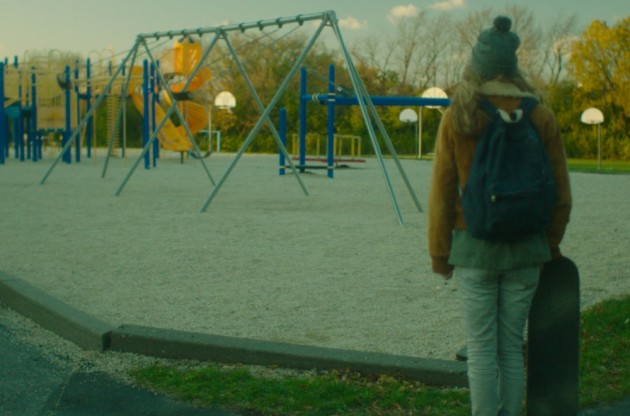
Empty Spaces
SM: I actually talked to David Robert Mitchell about making a horror film after The Myth of the American Sleepover because of the way he shot it, and he does a lot of it in It Follows, the way he shoots the pool party scenes at night, with two kids sitting at the pool and nothing in the background it just goes to blackness. It had a creepy sense in a teen drama. I never thought It Follows was very scary but the characters were great and the storyline. The same guy who did the coloring and the grading for It Follows did Anguish.
Offscreen: It is funny because when I watched the trailer for Anguish I noticed the color grading was different from the screening, darker.
SK: Yes that was just a temp version. It was only finished for the screening.
Offscreen: When you plan the Blu ray release, any special features in mind?
SM: Well, we have shot stuff on set, and interviews, the usual stuff.
Offscreen: You seem like you’d be good with a commentary track?
SM: That would be fine. I like talking about the film after screenings. I can never tell if I am being pretentious or informative. Maybe as a first time director I would talk about a lot of things that you really only learn at the beginning so say things that would or might be helpful for a new filmmaker.
Offscreen: Have all your films been shot on digital or have you shot on film?
SM: Well there are two sequences that were shot on Super 16mm in Anguish.
Offscreen: Which ones?
SM: When they first drive in, with Tess driving. I liked the way it looked on film. With the old pick up truck and the train, making you wonder, what year is this? And the India sequence.
Offscreen: That wasn’t shot in India?
SM: No, a bunch of Indians in Chicago. Not shot in India! A lot of Indian friends of the family. Some investors are also Indian. As a producer I realize that there is much less fighting from directors wanting to shoot on film. I love film, It looks beautiful, but now with some great digital camera, like the Arri Alexa, there is less resistance. In Chicago there are no more film labs, which is sort of unbelievable. I knew the guy who had the last film lab in Chicago, and asked him why did you shut down? Because they don’t shoot commercials or television on film anymore. Not enough to go around. I did have the choice to shoot film, but for a smaller movie when you have to send the film to LA and wait, it becomes hard, with the tight schedules. Ultimately I chose location over shooting on film. I knew the location which I love because we shot The Lake House there too. And our DP, Amanda Treyz.
Offscreen: Yes a woman, right. Not many in Hollywood.
SM: Well I’ve worked with three in a row now as a producer.
Offscreen: Is that a consequence of the digital revolution, which has maybe demystified the trade?
SM: I don’t know. There are still not a lot. I met bigger, more established DPs but she had an amazing eye. She added more movement than I had initially planned. She was very resourceful. She used the tilt lens to reflect the spirit world. She convinced me on the Arri Alexa digital camera. You can use these amazing 40 or 50 year old lenses. We tested lenses and watched films, like Ron Howard’s racing movie, Rush (2013) was shot with the Alexa and it is set in the 1970s and has that 70s look by using these old lenses. I prefer the Alexa to the Red cameras. But that is just me. I felt it had more of a film feel. Like I said I was willing to shoot the whole film on Super 16 but it is harder to sell a film shot on film. I find it crazy that there are programs designed to remove the grain! This is why I shot the pick-up truck scene on Super 16. It looks beautiful but I wanted it to look timeless.
Offscreen: And then you had a different visual style in the spirit battle scene, so that’s three different visual looks. So you were thinking in terms of style!
SM: Well the point was subtlety. How do you make an audience feel uncomfortable without them knowing that you are making them uncomfortable?
Offscreen : Well, I hope your film gets a major release.
SM: Yes, you and me both!
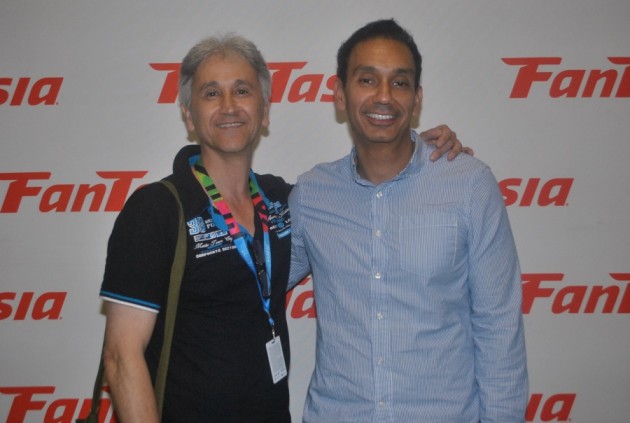
With Sonny Mallhi outside Fantasia Theatre room
Featured image from Anguish





